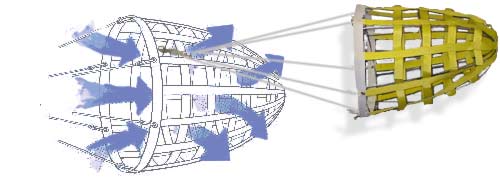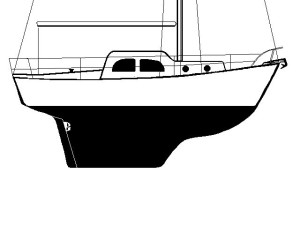Monohull, Islander
29' x 4 Tons, Full Keel & Cutaway Forefoot
36" Dia. Galerider Drogue
Force 8 Conditions
File D/M-7, obtained from William A. Forest, San Luis Obispo, CA. - Vessel name Seraphim, hailing port Morro Bay, CA, monohull, Islander Wayfarer, LOA 29' x LWL 24' x Beam 9.5' x Draft 4' x 4 Tons - Full keel & cutaway forefoot - Drogue: 36" Diameter Galerider on 200' x 1/2" nylon braid rode, with 1/2" stainless steel swivel - Deployed in a gale in deep water about 500 miles west of San Francisco, with winds of 35-45 knots and seas of 15-20 ft. - Vessel's stern yawed 20° - Speed averaged out to about 4 knots during 40 hours of deployment.
William A. Forest sailed Seraphim to Hawaii and back singlehanded in July 1989. On the way back he ran into a gale about 500 miles west of San Francisco. The wind was blowing out of the northwest, so he used a Galerider to slow Seraphim down and stabilize her attitude while continuing on in the right direction. Transcript:
I made the trip just to see if I could, and having done it I don't have to prove to myself that I can any more. The trip was made in 1989, when I was 66. The problem wasn't the boat, equipment or weather, but the chance that, as a single hander, I might get injured or break something. I did take a fall on the return trip, and cracked two lower ribs. I had not followed my own rule of wearing sneakers when on deck, and my bare feet went out from under me. Lucky it wasn't worse.
Until the time I deployed the Galerider on the way back, I had forgotten I had it on board. When the seas built up, the Monitor [wind vane] was unable to keep course as I sailed down into the troughs. The boat was surfing at that time, and the natural tendency was to try and round up, making it a dangerous broaching situation. This involved several hours of hand steering. Very tiring, at best. I took down the reefed main, hoisted the storm jib, and deployed the Galerider at 0200 hrs. on July 20th. I let out the Galerider rode to 150' initially, but later adjusted it between 125-200' to get best response, control and ride. The rode came in through the port after chock, taking half a turn on a corner cleat, then to my jib winch and onto another cleat. This way the strain was distributed between the first cleat and the winch, and I could take in or let out as the situation changed. As soon as the Galerider was deployed and the rode adjusted I had instant control. It was amazing. A note here that chafing gear must be used at the chock or the rode will easily wear through and the drogue be lost. It should also be noted that I had a 90 sq. ft. storm jib up. In order for the drogue to work properly it is necessary to have forward motion.
I adjusted the rode so that the Galerider was on the same side of the wave as the boat. In my case it was two waves back [on the same part of the wave as the boat]. I found that the strain was less on the line, and there were no jerks or rapid slowing as the boat moved forward. After deployment it was never necessary to hand-steer again. Once the Monitor wind vane was engaged I was able to unlash the tiller and my course became more exact. Sometime during early daylight hours a rogue wave from the port side carried away the wind vane sail and the dodger, filling the cockpit.
The Galerider worked well. There was plenty of searoom and the wind was blowing in the direction I wanted to go. However, in a situation of a dangerously close lee shore, and the loss of a rudder or sails, there is no doubt in my mind that a sea anchor would have been required. There is no law about not having both on board. In the unlikely event that I should go cruising again I would have both.
In subsequent telephone conversations Victor Shane asked William Forest why he didn't position the drogue on the back side of its wave when the yacht was surfing down the face of its wave (see Fig. 52). His answer was that he tried that, but given the particular situation - 35-knot winds - the yacht had a tendency to stall and wallow in the troughs. He added that in 50-knot winds he likely would have positioned the drogue on the "meatier" part of the wave.
In answer to the question as to whether he would prefer to take the seas squarely on the transom or on the quarter, Forest indicated that he would prefer to take them on the quarter with the drogue in tow, although it would depend on the particular circumstance. He stressed that every gale is different, every boat is different, and decisions such as where to position the drogue, or whether to use a bridle or not, or whether it is better to run directly downwind or to take the seas on the quarter are fluid decisions that need to be tailored to existing circumstances and conditions

